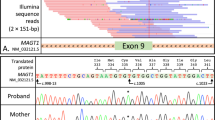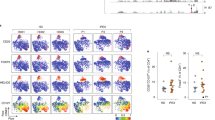Abstract
Insufficient dietary folate intake, hereditary malabsorption, or defects in folate transport may lead to combined immunodeficiency (CID). Although loss of function mutations in the major intestinal folate transporter PCFT/SLC46A1 was shown to be associated with CID, the evidence for pathogenic variants of RFC/SLC19A1 resulting in immunodeficiency was lacking. We report two cousins carrying a homozygous pathogenic variant c.1042 G > A, resulting in p.G348R substitution who showed symptoms of immunodeficiency associated with defects of folate transport. SLC19A1 expression by peripheral blood mononuclear cells (PBMC) was quantified by real-time qPCR and immunostaining. T cell proliferation, methotrexate resistance, NK cell cytotoxicity, Treg cells and cytokine production by T cells were examined by flow cytometric assays. Patients were treated with and benefited from folinic acid. Studies revealed normal NK cell cytotoxicity, Treg cell counts, and naive-memory T cell percentages. Although SLC19A1 mRNA and protein expression were unaltered, remarkably, mitogen induced-T cell proliferation was significantly reduced at suboptimal folic acid and supraoptimal folinic acid concentrations. In addition, patients’ PBMCs were resistant to methotrexate-induced apoptosis supporting a functionally defective SLC19A1. This study presents the second pathogenic SLC19A1 variant in the literature, providing the first experimental evidence that functionally defective variants of SLC19A1 may present with symptoms of immunodeficiency.
This is a preview of subscription content, access via your institution
Access options
Subscribe to this journal
Receive 6 digital issues and online access to articles
$119.00 per year
only $19.83 per issue
Buy this article
- Purchase on Springer Link
- Instant access to full article PDF
Prices may be subject to local taxes which are calculated during checkout




Similar content being viewed by others
Data availability
All the raw data are available upon reasonable request from the corresponding authors.
References
Shulpekova Y, Nechaev V, Kardasheva S, Sedova A, Kurbatova A, Bueverova E, et al. The concept of folic acid in health and disease. Molecules. 2021;26:3731.
Scaglione F, Panzavolta G. Folate, folic acid and 5-methyltetrahydrofolate are not the same thing. Xenobiotica. 2014;44:480–8.
Field MS, Kamynina E, Chon J, Stover PJ. Nuclear Folate Metabolism. Annu Rev Nutr. 2018;38:219–43.
Fernley RT, Iliades P, Macreadie I. A rapid assay for dihydropteroate synthase activity suitable for identification of inhibitors. Anal Biochem. 2007;360:227–34.
Fox JT, Stover PJ. Folate-mediated one-carbon metabolism. Vitam Horm. 2008;79:1–44.
Crider KS, Yang TP, Berry RJ, Bailey LB. Folate and DNA methylation: a review of molecular mechanisms and the evidence for folate’s role. Adv Nutr. 2012;3:21–38.
Courtemanche C, Elson-Schwab I, Mashiyama ST, Kerry N, Ames BN. Folate deficiency inhibits the proliferation of primary human CD8 + T lymphocytes in vitro. J Immunol. 2004;173:3186–92.
Mikkelsen K, Apostolopoulos V Vitamin B12, folic acid and the immune system. In: Mahmoudi M, Rezaei N, editors. Nutrition and Immunity. Switzerland: Springer; 2019. pp 103–14.
Koury MJ, Ponka P. New insights into erythropoiesis: the roles of folate, vitamin B12, and iron. Annu Rev Nutr. 2004;24:105–31.
Hou Z, Matherly LH. Biology of the major facilitative folate transporters SLC19A1 and SLC46A1. Curr Top Membr. 2014;73:175–204.
Alam C, Kondo M, O’Connor DL, Bendayan R. Clinical implications of folate transport in the central nervous system. Trends Pharm Sci. 2020;41:349–61.
Matherly LH, Wilson MR, Hou Z. The major facilitative folate transporters solute carrier 19A1 and solute carrier 46A1: Biology and role in antifolate chemotherapy of cancer. Drug Metab Dispos. 2014;42:632–49.
Desmoulin SK, Hou Z, Gangjee A, Matherly LH. The human proton-coupled folate transporter: Biology and therapeutic applications to cancer. Cancer Biol Ther. 2012;13:1355–73.
Antony AC. Folate receptors. Annu Rev Nutr. 1996;16:501–21.
Qiu A, Jansen M, Sakaris A, Min SH, Chattopadhyay S, Tsai E, et al. Identification of an intestinal folate transporter and the molecular basis for hereditary folate malabsorption. Cell. 2006;127:917–28.
Borzutzky A, Crompton B, Bergmann AK, Giliani S, Baxi S, Martin M, et al. Reversible severe combined immunodeficiency phenotype secondary to a mutation of the proton-coupled folate transporter. Clin Immunol. 2009;133:287–94.
Kishimoto K, Kobayashi R, Sano H, Suzuki D, Maruoka H, Yasuda K, et al. Impact of folate therapy on combined immunodeficiency secondary to hereditary folate malabsorption. Clin Immunol [Internet]. 2014;153:17–22.
Balashova OA, Visina O, Borodinsky LN. Folate action in nervous system development and disease. Dev Neurobiol. 2018;78:391–402.
Grapp M, Wrede A, Schweizer M, Hüwel S, Galla HJ, Snaidero N, et al. Choroid plexus transcytosis and exosome shuttling deliver folate into brain parenchyma. Nat Commun. 2013;4:2123.
Birn H, Spiegelstein O, Christensen EI, Finnell RH. Renal tubular reabsorption of folate mediated by folate binding protein 1. J Am Soc Nephrol. 2005;16:608–15.
Grapp M, Just IA, Linnankivi T, Wolf P, Lücke T, Häusler M, et al. Molecular characterization of folate receptor 1 mutations delineates cerebral folate transport deficiency. Brain. 2012;135:2022–31.
Tang LS, Santillano DR, Wlodarczyk BJ, Miranda RC, Finnell RH. Role of Folbp1 in the regional regulation of apoptosis and cell proliferation in the developing neural tLückeube and craniofacies. Am J Med Genet C Semin Med Genet. 2005;135C:48–58.
Spiegelstein O, Mitchell LE, Merriweather MY, Wicker NJ, Zhang Q, Lammer EJ, et al. Embryonic development of folate binding protein-1 (Folbp1) knockout mice: Effects of the chemical form, dose, and timing of maternal folate supplementation. Dev Dyn. 2004;231:221–31.
Zhu H, Cabrera RM, Wlodarczyk BJ, Bozinov D, Wang D, Schwartz RJ, et al. Differentially expressed genes in embryonic cardiac tissues of mice lacking Folr1 gene activity. BMC Dev Biol. 2007;7:128.
Yang-Feng TL, Ma YY, Liang R, Prasad PD, Leibach FH, Ganapathy V. Assignment of the human folate transporter gene to chromosome 21q22.3 by somatic cell hybrid analysis and in situ hybridization. Biochem Biophys Res Commun. 1995;210:874–9.
Kotnik BF, Jazbec J, Grabar PB, Rodriguez-Antona C, Dolzan V. Association between SLC19A1 gene polymorphism and high dose methotrexate toxicity in childhood acute lymphoblastic leukaemia and non hodgkin malignant lymphoma: introducing a haplotype based approach. Radio Oncol. 1751;20:455–62.
Coppedè F, Stoccoro A, Tannorella P, Gallo R, Nicolì V, Migliore L. Association of polymorphisms in genes involved in one-carbon metabolism with MTHFR methylation levels. Int J Mol Sci. 2019;20:3754.
Gelineau-van Waes J, Heller S, Bauer LK, Wilberding J, Maddox JR, Aleman F, et al. Embryonic development in the reduced folate carrier knockout mouse is modulated by maternal folate supplementation. Birth Defects Res A Clin Mol Teratol. 2008;82:494–507.
Zhao R, Russell RG, Wang Y, Liu L, Gao F, Kneitz B, et al. Rescue of embryonic lethality in reduced folate carrier-deficient mice by maternal folic acid supplementation reveals early neonatal failure of hematopoietic organs. J Biol Chem. 2001;276:10224–8.
Svaton M, Skvarova Kramarzova K, Kanderova V, Mancikova A, Smisek P, Jesina P, et al. A homozygous deletion in the SLC19A1 gene as a cause of folate-dependent recurrent megaloblastic anemia. Blood 2020;135:2427–31.
Tangye SG, Al-Herz W, Bousfiha A, Cunningham-Rundles C, Franco JL, Holland SM, et al. Human Inborn Errors of Immunity: 2022 Update on the Classification from the International Union of Immunological Societies Expert Committee. J Clin Immunol. 2022:1–35.
Ferguson PL, Flintoff WF. Topological and functional analysis of the human reduced folate carrier by hemagglutinin epitope insertion. J Biol Chem. 1999;274:16269–78.
Alnabbat KI, Fardous AM, Cabelof DC, Heydari AR. Excessive folic acid mimics folate deficiency in human lymphocytes. Curr Issues Mol Biol. 2022;44:1452–62.
Sharma R, Ali T, Kaur J. Folic acid depletion as well as oversupplementation helps in the progression of hepatocarcinogenesis in HepG2 cells. Sci Rep. 2022;12:16617.
Zhang M, Bracaglia C, Prencipe G, Bemrich-Stolz CJ, Beukelman T, Dimmitt RA, et al. A heterozygous RAB27A mutation associated with delayed cytolytic granule polarization and hemophagocytic lymphohistiocytosis. J Immunol. 2016;196:2492–503.
Kinoshita M, Kayama H, Kusu T, Yamaguchi T, Kunisawa J, Kiyono H, et al. Dietary folic acid promotes survival of Foxp3+ regulatory T cells in the colon. J Immunol. 2012;189:2869–78.
Luteijn RD, Zaver SA, Gowen BG, Wyman SK, Garelis NE, Onia L, et al. SLC19A1 transports immunoreactive cyclic dinucleotides. Nature. 2019;573:434–8.
Ritchie C, Cordova AF, Hess GT, Bassik MC, Li L. SLC19A1 is an importer of the immunotransmitter cGAMP. Mol Cell. 2019;75:372-81.e5.
Ifergan I, Jansen G, Assaraf YG. The reduced folate carrier (RFC) is cytotoxic to cells under conditions of severe folate deprivation. RFC as a double edged sword in folate homeostasis. J Biol Chem. 2008;283:20687–95.
Yilmaz E, Özcan A, Gök V, Karakükçü M, Ünal E. The effect of methylenetetrahydrofolate reductase polymorphisms on the methotrexate toxicity in children with acute lymphoblastic leukemia: Methylenetetrahydrofolate reductase & methotrexate toxicity. J Transl Pract Med. 2022;1:9–13.
Wu CH, Huang TC, Lin BF. Folate deficiency affects dendritic cell function and subsequent T helper cell differentiation. J Nutr Biochem. 2017;41:65–72.
Besci Ö, Baser D, Öğülür İ, Berberoğlu AC, Kıykım A, Besci T, et al. Reference values for T and B lymphocyte subpopulations in Turkish children and adults. Turk J Med Sci. 2021;51:1814–24.
Funding
This study was financially supported by Erciyes University BAP grant (TCD-2021-10863) to EÜ, and Turkish Academy of Science GEBIP and Science Academy BAGEP awards to AE.
Author information
Authors and Affiliations
Contributions
Conceptualization was performed by AE, EÜ. Methodology was performed by ŞE, YH, SB, KEB, CA, AE, MFC. Software was performed by AB. Investigation was performed by VG, ŞE, AÖ, EY, HP, TP, AE, EÜ. Validation was done by AB, MK, AE. Supervision was performed HC, AE, EÜ. Resources—Writing—original draft were written by VG, ŞE, YH, AE. Writing—review & editing were performed by VG, YH, SB, AÖ, EY, CA, MK, HC, HP, TP, AE, EÜ. Funding acquisition by AE, EÜ. All authors have read and approved the manuscript.
Corresponding authors
Ethics declarations
Competing interests
The authors declare no competing interests.
Ethics approval
All experimental procedures were approved by Erciyes University institutional review board (#2021/17) and conducted according to regulations. Parents of the patients signed the informed consents for the immunological study and provided consent for the publication of data. Controls were selected randomly from amongst the age and sex-matched healthy donors.
Consent to participate
Written informed consent was obtained from the parents.
Consent to publish
The authors affirm that human research participants provided informed consent for publication of the images in (Fig. 1).
Additional information
Publisher’s note Springer Nature remains neutral with regard to jurisdictional claims in published maps and institutional affiliations.
Supplementary information
Rights and permissions
Springer Nature or its licensor (e.g. a society or other partner) holds exclusive rights to this article under a publishing agreement with the author(s) or other rightsholder(s); author self-archiving of the accepted manuscript version of this article is solely governed by the terms of such publishing agreement and applicable law.
About this article
Cite this article
Gök, V., Erdem, Ş., Haliloğlu, Y. et al. Immunodeficiency associated with a novel functionally defective variant of SLC19A1 benefits from folinic acid treatment. Genes Immun 24, 12–20 (2023). https://doi.org/10.1038/s41435-022-00191-7
Received:
Revised:
Accepted:
Published:
Issue Date:
DOI: https://doi.org/10.1038/s41435-022-00191-7



